With $1 Million, You Can Save Philip Johnson’s First Commissioned House
Those who have dreamed of living in Philip Johnson’s renowned Glass House now have the chance to roost in its immediate precursor and the architect’s first built commission—the Booth House in Bedford, New York.
Completed in 1946, the residence was originally built for an advertising executive and his wife before becoming a rental property for the groundbreaking architectural photographer Robert Damora and architect Sirkka Damora in 1955. The Damoras, who went on to purchase the home, have been the custodians of the house ever since. Now 93 years old, Sirkka urgently seeks a new owner for this piece of architectural history, which is being offered at $1 million. Litigation over the title means that the Booth House faces being torn down, so its buyer will also be its rescuer.
Boasting expansive glass walls and a central brick fireplace, the Booth House exhibits the same elements that Johnson bestowed the Glass House, which was completed three years later. The dwelling comes as part of a post-World War II housing experiment to create affordable homes with new building technologies, and it makes use of modest materials like concrete blocks and plate glass. Booth House takes a simple rectangular form, and its open plan encourages shared family experiences. "This is a town of large Colonial Revival houses," says the Damoras’ son, Matthew Damora. "Folks were not used to what we were doing, but it’s all my sister and I ever knew."
Twenty-eight feet of floor-to-ceiling glass allows nature to permeate living spaces. Matthew remembers experiencing snowstorms in the house: "You can watch snowflakes flutter down from the treetops to the ground. It’s an involvement with the exterior that you don’t have with traditional housing." As a child, he also took advantage of the large door in his bedroom, stepping out to wander in the moonlight without his parents knowing. Sirkka recalls glimpsing the Northern Lights from the home.
Expanding the living space from 1,450 square feet to 2,320 square feet, the Damoras transformed a rough basement into office space for their architectural practice, adding a sunken courtyard and a glass wall. Johnson, whose buildings were photographed by Robert Damora, even came by to approve the project. "He thought it was totally within the vocabulary of what he’d done," says Matthew. The couple also built a separate 800-square-foot studio with a large skylight, which sits in dialogue with the house on two acres of mature woodland.
For more information about the Booth House or to schedule a showing, contact Matthew Damora at r.damora@verizon.net or (718) 230-8858.
Published
Last Updated
Get the Dwell Newsletter
Be the first to see our latest home tours, design news, and more.









